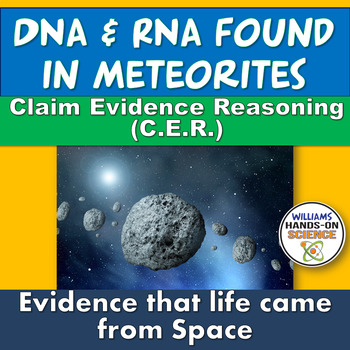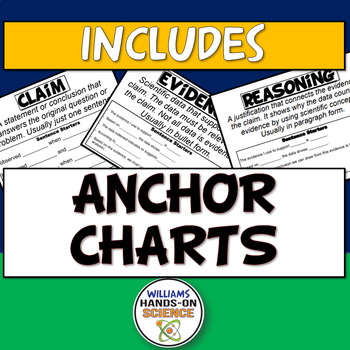DNA Origins of Life Molecules to Organisms Evolution Claim Evidence Reasoning
- Zip
Description
Students learn how DNA and RNA found on meteorites is evidence that life’s precursors came from space through a C.E.R. (Claim Evidence Reasoning) graphic organizer. This is great for getting your students to explain phenomena in a meaningful way and it allows you as the instructor to adequately assess their understanding of concepts. The students figure out what the "Claim" is in the article, they then use data that supports the claim in the "Evidence" section, draw visual evidence and then explain why the evidence supports the claim in the "Reasoning" section.
The article has the following concepts:
DNA and RNA
Amino Acids
Adenine, Guanine, Cytosine, Thymine and Uracil
Sugars and Phosphates
Base Pairs
Genetic Code
Organic Compounds
Isomers
Chemical Formulas
Take a look at my CER Mega bundle!
This is great for a current event, sub plan, homework, critical thinking, scaffolding and/or reinforcement of concepts!
You get a CER graphic organizer, an editable key, the article, tips for CER and the link to the website in the article.
NGSS Standards:
Middle School:
MS-LS1 From Molecules to Organisms: Structures and Processes
LS4.A: Evidence of Common Ancestry and Diversity
The collection of fossils and their placement in chronological order (e.g., through the location of the sedimentary layers in which they are found or through radioactive dating) is known as the fossil record. It documents the existence, diversity, extinction, and change of many life forms throughout the history of life on Earth. (MS-LS4-1)
PS1.A: Structure and Properties of Matter
Each pure substance has characteristic physical and chemical properties (for any bulk quantity under given conditions) that can be used to identify it.
High School:
HS-LS1 From Molecules to Organisms: Structures and Processes
Construct an explanation based on evidence for how the structure of DNA determines the structure of proteins, which carry out the essential functions of life through systems of specialized cells
All cells contain genetic information in the form of DNA molecules.
Genes are regions in the DNA that contain the instructions that code for the formation of proteins, which carry out most of the work of cells.
The sugar molecules thus formed contain carbon, hydrogen, and oxygen: their hydrocarbon backbones are used to make amino acids and other carbon-based molecules that can be assembled into larger molecules (such as proteins or DNA), used for example to form new cells. (HS-LS1-6)
SEP's
Asking Questions and Defining Problem:
Students at any grade level should be able to ask questions of each other about the texts they read, the features of the phenomena they observe, and the conclusions they draw from their models or scientific investigations.
Engaging in Argument from Evidence:
In 9–12 builds on K–8 experiences and progresses to using appropriate and sufficient evidence and scientific reasoning to defend and critique claims and explanations about the natural and designed world(s). Arguments may also come from current scientific or historical episodes in science.
Construct an explanation based on valid and reliable evidence obtained from a variety of sources (including students' own investigations, models, theories, simulations, peer review) and the assumption that theories and laws that describe the natural world operate today as they did in the past and will continue to do so in the future. (HS-ESS1-2)
CCC's
CCC1: Patterns
Observed patterns of forms and events guide organization and classification, and they prompt questions about relationships and the factors that influence them.
Systems and System Models
Models (e.g., physical, mathematical, computer models) can be used to simulate systems and interactions—including energy, matter, and information flows—within and between systems at different scales. (HS-LS2-5)
Energy and Matter
Changes of energy and matter in a system can be described in terms of energy and matter flows into, out of, and within that system. (HS-LS1-5), (HS-LS1-6)
Energy cannot be created or destroyed—it only moves between one place and another place, between objects and/or fields, or between systems. (HS-LS1-7), (HS-LS2-4)
Energy drives the cycling of matter within and between systems. (HS-LS2-3)
TERMS OF USE
• All rights reserved by Williams Hands On Science, Inc.
• This product is to be used by the original purchaser only.
• Intended for classroom and personal use only.
• Copying for more than one teacher, classroom, department, school, or school system is prohibited.
• This product may not be distributed or displayed digitally for public view.
• Failure to comply is a copyright infringement and a violation of the Digital Millennium Copyright Act (DMCA).
If there are any errors or questions, please contact me through TpT or email me at:
williamshandsonscience@gmail.com
Thank you for taking a look!
Please follow me on TpT for new products and check me out on Instagram for my products in action!
https://www.instagram.com/williams_hands_on_science/
Related Products
⭐ Claim Evidence Reasoning (CER): Autumn Equinox Can Fall on Different Days
⭐ Claim Evidence Reasoning Growing Bundle
⭐ NGSS Black Holes & Galaxies Claim Evidence Reasoning Graphic Organizer
⭐ NGSS Claim Evidence Reasoning (CER) Big Bang Graphic Organizer
⭐ NGSS Claim Evidence Reasoning (CER) High Frequency Sound Waves
⭐ NGSS Claim Evidence Reasoning The Mysterious Planet Nine Solar System Astronomy
⭐ NGSS Claim Evidence Reasoning (CER) Water Found on Mars
⭐ ⭐ NGSS Common Core Claim Evidence Reasoning (CER) Graphic Organizers
⭐ NGSS Expanding Universe Claim Evidence Reasoning Graphic Organizer





